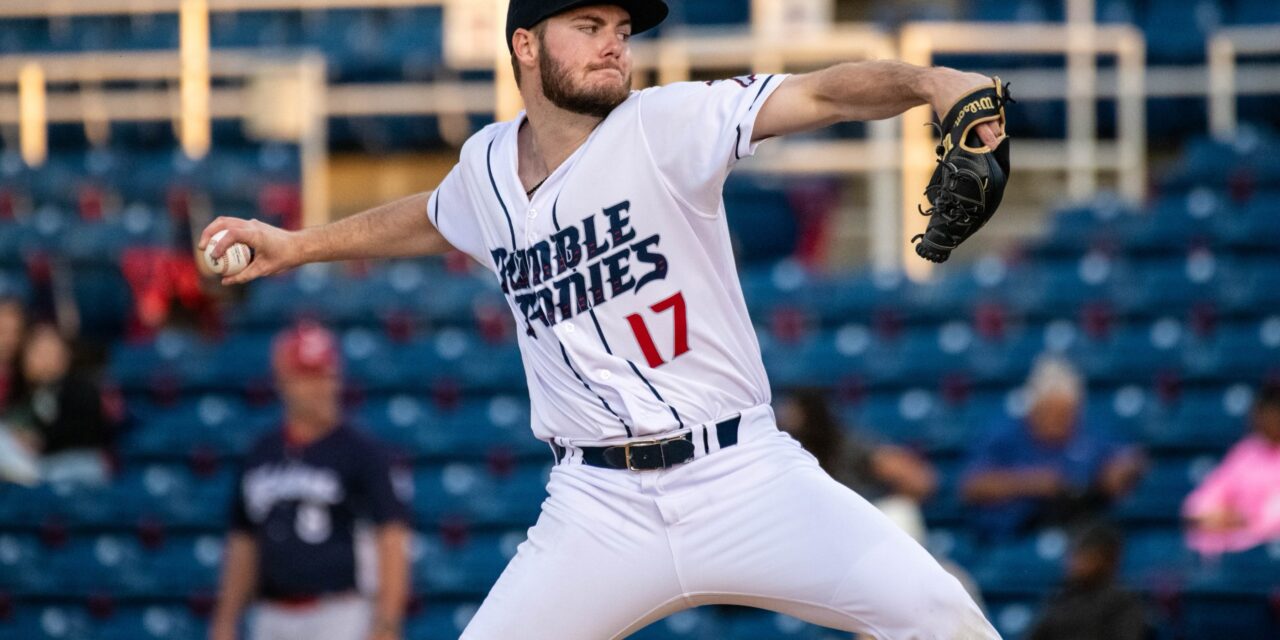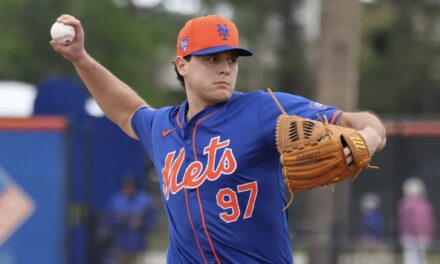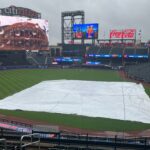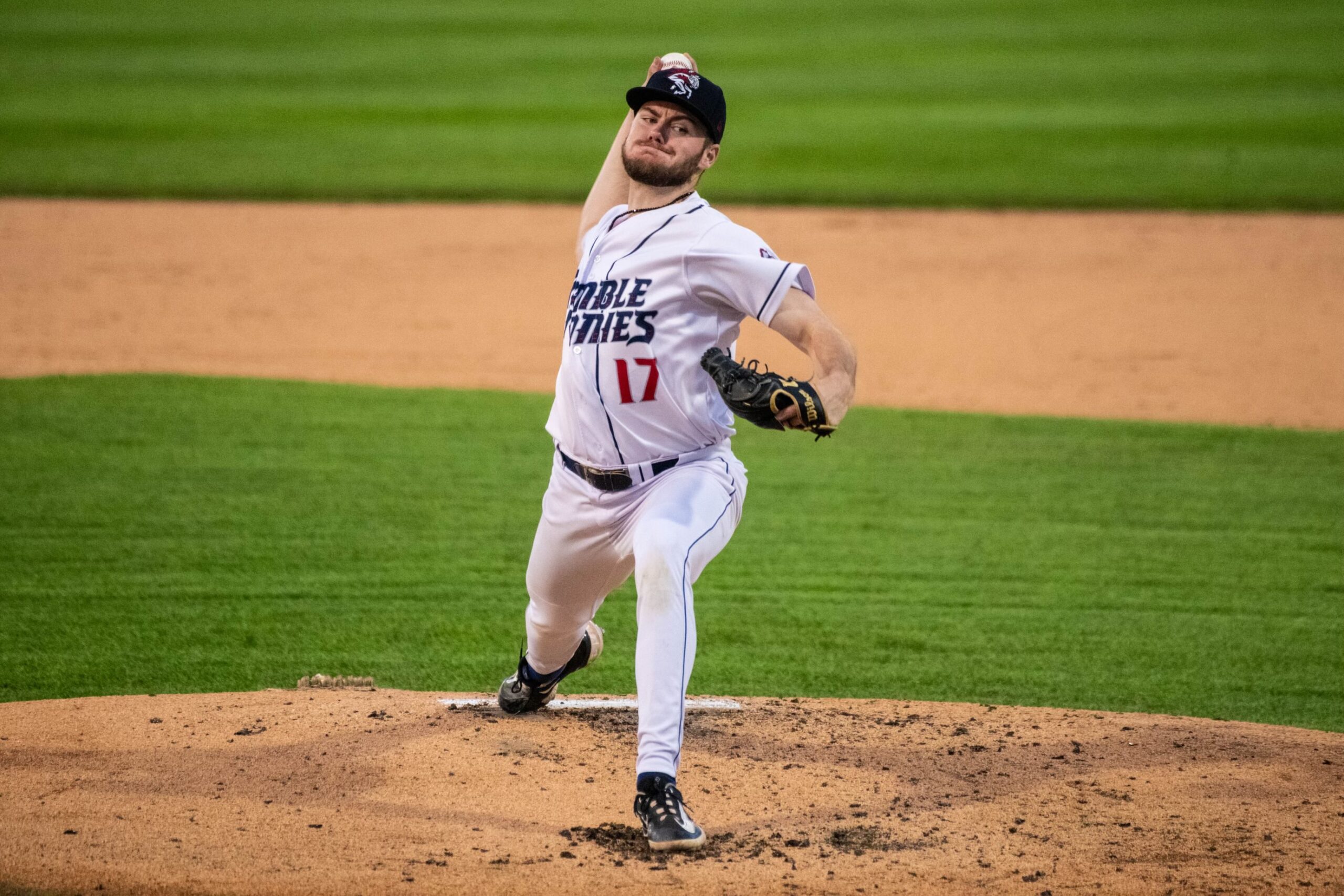
Christian Scott. Photo by Bronson Harris of the Binghamton Rumble Ponies
Not all minor leaguers in the Mets’ system will make it to the majors, but that doesn’t mean that some of those pitchers don’t have “big league” pitches in their arsenal. The below is a list of some of the top strikeout pitches in the 2023 season from some pitchers in the Mets’ system, regardless of their prospect status or likelihood of getting to Queens.
Christian Scott – RHP
The 2023 Mets’ MiLB pitcher of the year has a complete arsenal and had 30%-plus strikeout rates at both levels Christian Scott pitched at while putting up sub-5% walk rates. Typically, pitchers with incredibly low walk rates generate more contact due to high in zone rates and thus have lower strikeout rates. Scott’s combination of low walks and strikeouts reveals just how elite his “stuff” is.
While he does have an elite splitter and slider, he uses his fastball over 50% of the time and maintains that high usage rate even with two strikes. The fastball is his bread and butter and because he averages nearly 95 mph as a starter, with plus extension, strategic location at the top of the zone, and lower than average release height, it is a MLB-grade offering.
While he might eventually lower its usage in the big leagues, he projects as a plus MLB starter.
Jace Beck – RHP
Jace Beck‘s fastball was used at an extremely high rate this year at over two-thirds of the time. His extension on the pitch is well over seven feet, putting him amongst the lengthiest arms in baseball. Of course, at six-foot-nine, he is also one of the more unusual frames for pitchers, falling short of only the Giants’ Sean Hjelle.
While he also throws a slider, the miss rates on that pitch are low, showing how he truly dominates with the fastball to get his strikeouts. The fastball averages between 93 and 94 mph and reached as high as 97 mph. He struck out 57 hitters in 31 2/3 innings in Brooklyn (High-A) this season, equating to a 38% strikeout rate, nearly 14% above league average.
This pitch could be a ticket to the big leagues for Beck if he can manage to lower his walk numbers that sat at 20% this year, nearly double the league average.
Eric Orze – RHP
Eric Orze had an up-and-down season in Syracuse (Triple-A) in 2023 but put up an impressive 30% strikeout rate over the full season. His 81 strikeouts across 61 innings were among the leaders for Mets’ minor league relievers, largely due to his splitter.
His splitter is his primary pitch and is used against both righties and lefties despite platooning better against left-handed hitters. While his fastball’s effectiveness has waned a bit in recent years, the splitter is as good as ever.
He throws the split 46% of the time, averaging just one inch of vertical break on the pitch, a 17-inch difference from his fastball. It has over a 50% whiff rate and is thrown in the zone at a high rate. This will lead him to the big leagues if he can manage to improve his secondary pitches in any way.
Nate Lavender – LHP
Nate Lavender posted breakout numbers between Double-A and Triple-A, racking up 86 strikeouts across 54 innings. He posted a 37% strikeout rate across both levels with better than league average walk rates. His success came in large part because of his fastball.
While he averages a mere 92 mph on the pitch, touching as high as 96, he has better than average vertical break on it at 16.5 inches and has a low release height. His near five-foot release height is among the lower pitchers in the game, and as a lefty, it’s an even more unique look.
A good comparison would be Paul Sewald but from the left side. As a result, his vertical approach angle on the pitch (how flat it is) makes hitters swing underneath it at a mind boggling rate of nearly 40% which is almost unheard of for a heater.
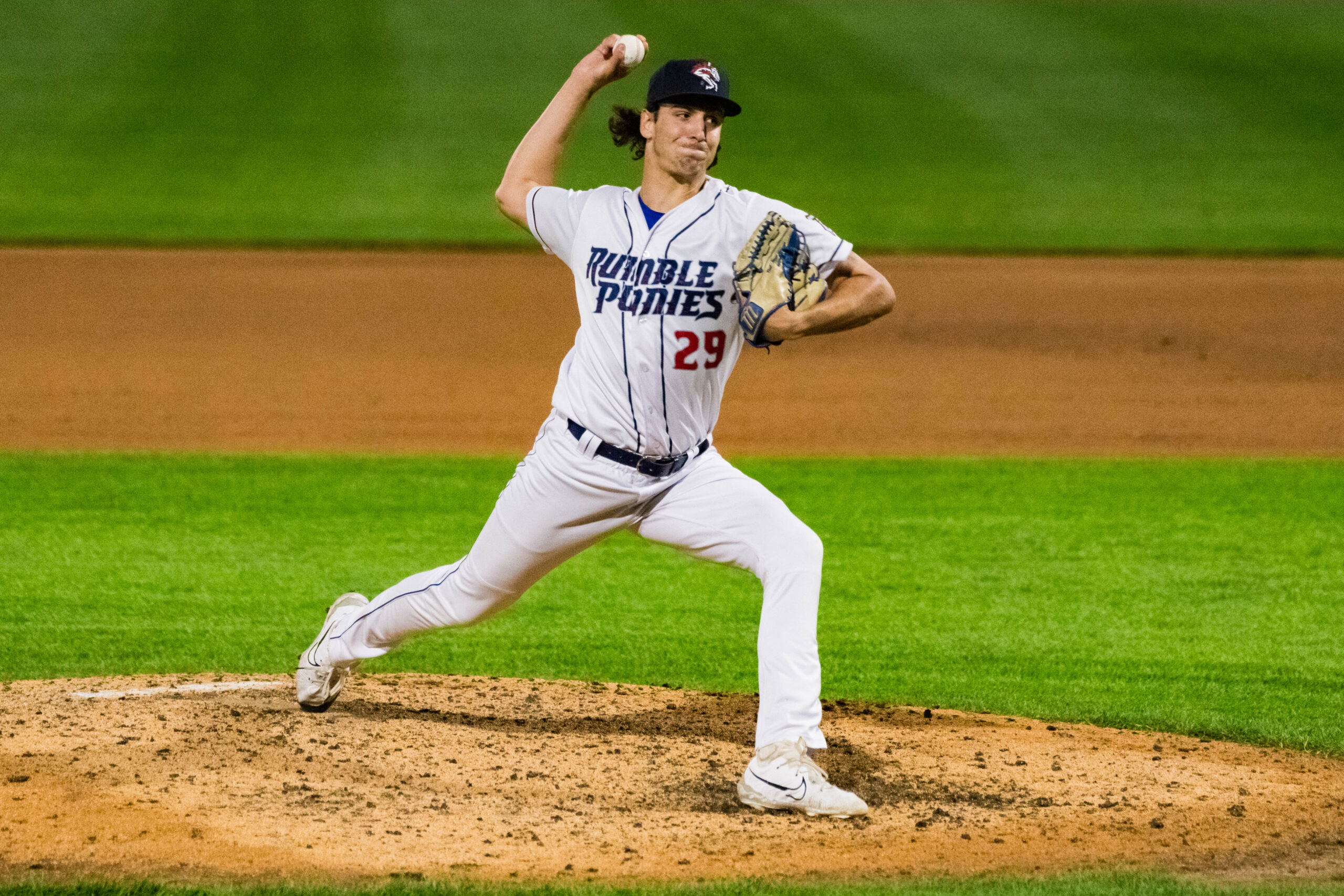
Paul Gervase. Photo by Bronson Harris of the Binghamton Rumble Ponies
Paul Gervase – RHP
Paul Gervase punched out 98 hitters across 58 innings in 2023 — nearly two per inning. His 39% strikeout rate leads this group, and while he has multiple swing-and-miss weapons, he primarily dominates with his fastball.
His fastball is similar to Beck’s but with better execution and better off speed to complete the arsenal. He also has well above seven-foot extension, averages 93-95 mph on the pitch, has average vertical break, and a low-release height. The fastball, touching as high as 98 mph, has a much higher perceived velocity due to his extension, and the pitch rides more than the movement indicates due to the lower release height.
While he often throws the pitch at the bottom of the zone, he still finds plenty of misses on it due to these outlier release characteristics.
Dylan Tebrake – RHP
While Dylan Tebrake did make it up to Double-A in 2023 with a five inning sample, the majority of his year was spent in Brooklyn (High-A) where he put up an impressive 39% strikeout rate. His best pitch is his slider which has some qualities of a cutter with slight backspin. While the pitch barely qualifies as a slider, he averages 88 mph on it, well above MLB average for a slider.
He also saw hitters miss the pitch over half the time they swung last season, differentiates it well from his fastball which sits in the mid-90 mph range, and locates it well.
His arsenal screams MLB reliever and matches up nicely to the pitch types that the Dodgers love so much.
Bailey Reid – RHP
Bailey Reid was a mid-season pickup by the Mets after he was released by the Cubs. A former Driveline trainee and a known commodity to Eric Jagers, Reid had big time command problems with the Cubs in High-A to start the season, eclipsing a 25% walk rate.
While his command didn’t improve much with the Mets, posting a 20% walk rate on the season with his new organization, he has a powerful arm and an elite slider. His slider is a smaller sweeper with a bit of depth and averages mid-80 mph range with the pitch, touching nearly 90 mph with it at its peak.
With the slider as the primary two strike pitch and fastball averaging mid-90 mph range, he has a versatile arsenal that could perform in MLB if he was able to improve his in-zone rates.
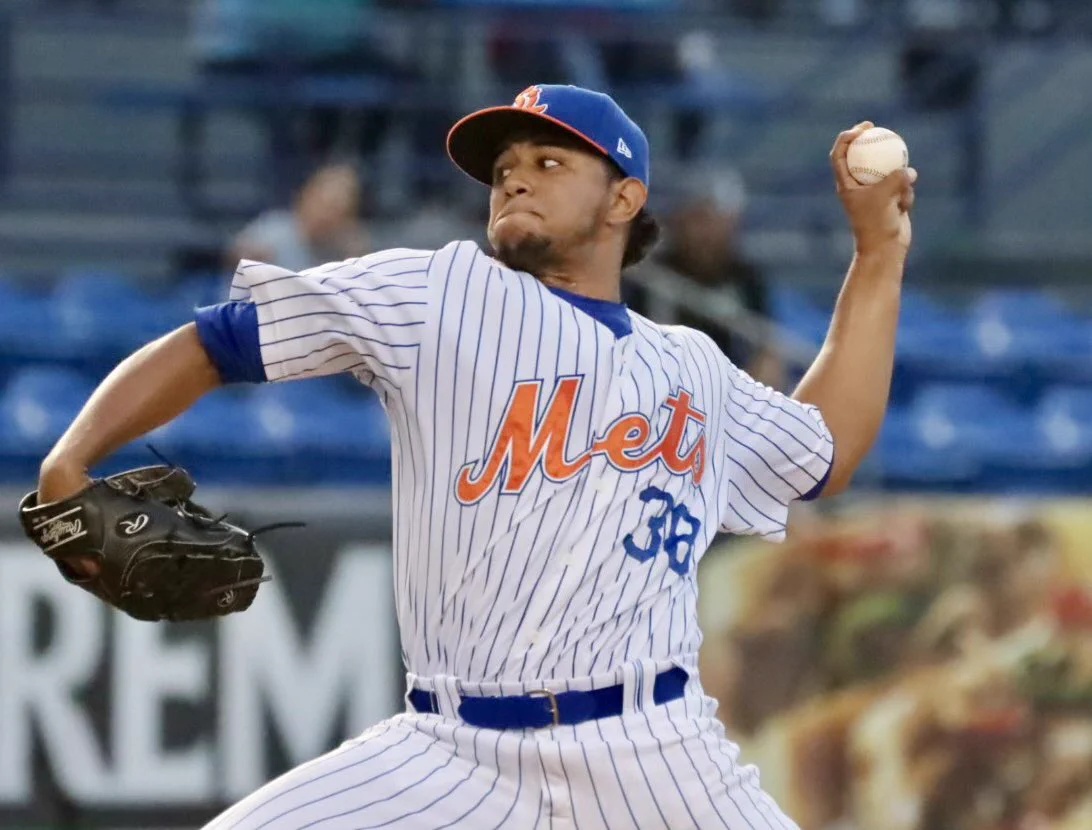
Daniel Juarez. Photo by Ed Delany of MMO
Daniel Juarez – LHP
Daniel Juarez‘s fastball is also his best pitch but not in the same way as the others. His fastball won’t blow hitters away but it averages an elite 20 inches of vertical break, qualifying it for the “unicorn zone.” While his velocity plays up as a lefty, he will likely need to lower its usage at the higher levels.
He threw the heater at over 60% of the time in 2023 and saw his strikeout numbers drop drastically from Brooklyn (High-A) to Binghamton (Double-A) from over 40% to barely over 20% and below league average.
Jonah Tong – RHP
The 2022 seventh-round pick out of Georgia Premier Academy is just 20 years old and a bit raw on the mound, but Jonah Tong put up some impressive swing-and-miss numbers in his first professional season. He struck out 38 hitters across 21 2/3 innings across two levels – the Florida Complex League and Florida State Leagues – in 2023. While his “fastball” is his best pitch and the reason he made this list, calling it a fastball simply doesn’t do the pitch justice.
His fastball qualifies as a fastball with “cut-ride” movement, moving with almost no horizontal movement and high amounts of vertical break and “ride.” The two qualities not only make the pitch a good swing-and-miss offering and a major contributor to his strikeout numbers this season, but also make it a ground ball pitch, which is a rare quality for a four-seamer.
This fastball profile is a slightly more miss-oriented version of fellow Mets’ minor leaguer Brian Metoyer, who posted breakout numbers in the 2021 season due mostly to his fastball movement.


